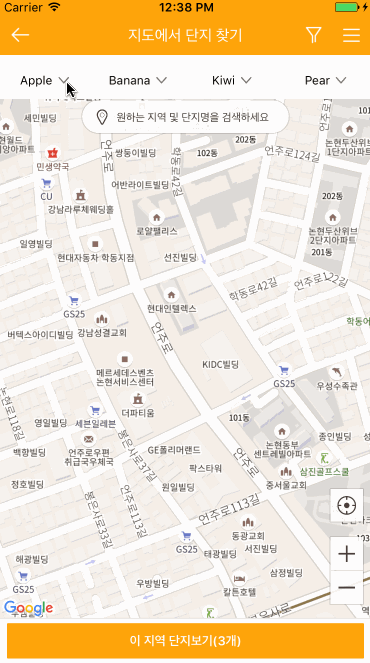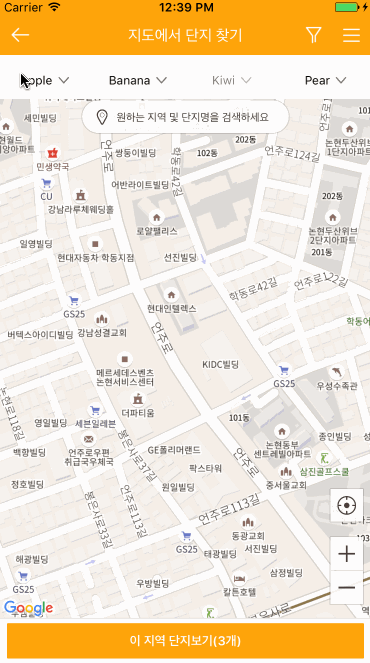YNDropDownMenu alternatives and similar libraries
Based on the "Menu" category.
Alternatively, view YNDropDownMenu alternatives based on common mentions on social networks and blogs.
-
Pagemenu
A paging menu controller built from other view controllers placed inside a scroll view (like Spotify, Windows Phone, Instagram) -
SideMenu
Simple side/slide menu control for iOS, no code necessary! Lots of customization. Add it to your project in 5 minutes or less. -
SlideMenuControllerSwift
iOS Slide Menu View based on Google+, iQON, Feedly, Ameba iOS app. It is written in pure swift. -
CircleMenu
:octocat: ⭕️ CircleMenu is a simple, elegant UI menu with a circular layout and material design animations. Swift UI library made by @Ramotion -
GuillotineMenu
Our Guillotine Menu Transitioning Animation implemented in Swift reminds a bit of a notorious killing machine. -
PagingKit
PagingKit provides customizable menu UI. It has more flexible layout and design than the other libraries.
WorkOS - The modern identity platform for B2B SaaS

* Code Quality Rankings and insights are calculated and provided by Lumnify.
They vary from L1 to L5 with "L5" being the highest.
Do you think we are missing an alternative of YNDropDownMenu or a related project?
README
YNDropDownMenu
Updates
See CHANGELOG for details
Introduction
The eligible dropdown menu for iOS, written in Swift 5, appears dropdown menu to display a view of related items when a user click on the dropdown menu. You can customize dropdown view whatever you like (e.g. UITableView, UICollectionView... etc)


Requirements
YNDropDownMenu written in Swift 5. Compatible with iOS 8.0+
Installation
Cocoapods
YNDropDownMenu is available through CocoaPods. To install it, simply add the following line to your Podfile:
pod 'YNDropDownMenu'
Carthage
github "younatics/YNDropDownMenu"
Usage
import YNDropDownMenu
Init view with frame[CGRect], Views[UIView] and Titles[String]
let view = YNDropDownMenu(frame:frame, dropDownViews: dropDownViews, dropDownViewTitles: ["Apple", "Banana", "Kiwi", "Pear"])
self.addSubview(view)
done!
Inherit YNDropDownView (If you need)
class DropDownView: YNDropDownView {
// override method to call open & close
override func dropDownViewOpened() {
print("dropDownViewOpened")
}
override func dropDownViewClosed() {
print("dropDownViewClosed")
}
// Hide Menu
self.hideMenu()
// Change Menu Title At Index
self.changeMenu(title: "Changed", at: 1)
self.changeMenu(title: "Changed", status: .selected, at: 1)
// Change View At Index
self.changeView(view: UIView(), at: 3)
// Always Selected Menu
self.alwaysSelected(at: 0)
self.normalSelected(at: 0)
}
Customize
Show & Hide Menu
view.showAndHideMenu(at:1)
// When view is already opened
view.hideMenu()
Disable & Enable Menu
view.disabledMenu(at: 2)
view.enabledMenu(at: 3)
Always/Normal selected button label
view.alwaysSelected(at: 0)
view.normalSelected(at: 0)
Button Images with 3 situations (normal, selected, disabled)
view.setStatesImages(normalImages: [UIImage(named: "arrow_nor")], selectedImages: [UIImage(named: "arrow_sel")], disabledImages: [UIImage(named: "arrow_dim")])
Label color with 3 situations
view.setLabelColorWhen(normal: UIColor.black, selected: UIColor.blue, disabled: UIColor.gray)
Label font with 3 situations
view.setLabelFontWhen(normal: UIFont.systemFont(ofSize: 12), selected: UIFont.boldSystemFont(ofSize: 12), disabled: UIFont.systemFont(ofSize: 12))
BlurEffectView
// Enadbled or Disabled first (Default true)
view.backgroundBlurEnabled = false
// Use this line if you want to change UIBlurEffectStyle
view.blurEffectStyle = .light
// Or customize blurEffectView(UIView)
let backgroundView = UIView()
backgroundView.backgroundColor = UIColor.black
view.blurEffectView = backgroundView
// Animation end alpha
view.blurEffectViewAlpha = 0.7
Animation duration
view.showMenuDuration = 0.5
view.hideMenuDuration = 0.3
Animation velocity, damping
view.showMenuSpringVelocity = 0.5
view.showMenuSpringWithDamping = 0.8
view.hideMenuSpringVelocity = 0.9
view.hideMenuSpringWithDamping = 0.8
Change Menu Title At Index
view.changeMenu(title: "Changed", at: 1)
view.changeMenu(title: "Changed", status: .selected, at: 1)
Change View At Index
view.changeView(view: UIView(), at: 3)
Change Bottom Line
view.bottomLine.backgroundColor = UIColor.black
view.bottomLine.isHidden = false
Deprecated
extension YNDropDownMenu {
@available(*, deprecated, message: "use init(frame: CGRect, dropDownViews: [UIView], dropDownViewTitles: [String]) instead")
public init(frame: CGRect, YNDropDownViews: [YNDropDownView], dropDownViewTitles: [String])
@available(*, deprecated, message: "use alwaysSelected(at index: Int) instead")
open func alwaysSelectedAt(index: Int) {
self.alwaysSelected(at: index)
}
@available(*, deprecated, message: "use disabledMenu(at index: Int) instead")
open func disabledMenuAt(index: Int) {
self.disabledMenu(at: index)
}
@available(*, deprecated, message: "use enabledMenu(at index: Int) instead")
open func enabledMenuAt(index: Int) {
self.enabledMenu(at: index)
}
@available(*, deprecated, message: "use showAndHideMenu(at index: Int) instead")
open func showAndHideMenuAt(index: Int) {
self.showAndHideMenu(at: index)
}
}
extension YNDropDownView {
@available(*, deprecated, message: "use changeMenu(title: String, at index: Int) instead")
open func changeMenuTitleAt(index: Int, title: String) {
self.delegate?.changeMenu(title: title, at: index)
}
}
References
Please tell me or make pull request if you use this library in your application :)
@zigbang
MotionBook
Author
Thanks to
License
YNDropDownMenu is available under the MIT license. See the LICENSE file for more info.
*Note that all licence references and agreements mentioned in the YNDropDownMenu README section above
are relevant to that project's source code only.







